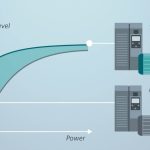Magnetic field due to an electric current Magnetic fields can be set up not only by permanent magnets, but also by electric currents.
Let a piece of wire be arranged to pass vertically through a horizontal sheet of cardboard, on which is placed some iron filings, as shown in Figure 8.1(a).
If a current is now passed through the wire, then the iron filings will form a definite circular field pattern with the wire at the centre, when the cardboard is gently tapped. By placing a compass in different positions the lines of flux are seen to have a definite direction as shown in Figure 8.1(b). If the current direction is reversed, the direction of the lines of flux is also reversed. The effect on both the iron filings and the compass needle disappears when the current is switched off. The magnetic field is thus


‘If a normal right-hand thread screw is screwed along the conductor in the direction of the current, the direction of rotation of the screw is in the direction of the magnetic field.’
For example, with current flowing away from the viewer (Figure 8.3(a)) a right-hand thread screw driven into the paper has to be rotated clockwise. Hence the direction of the magnetic field is clockwise.
A magnetic field set up by a long coil, or solenoid, is shown in Figure 8.4(a) and is seen to be similar to that of a bar magnet. If the solenoid is wound on an iron bar, as shown in Figure 8.4(b), an even stronger magnetic field is produced, the iron becoming magnetized and behaving like a permanent magnet.
The direction of the magnetic field produced by the current I in the solenoid may be found by either of two methods, i.e. the screw rule or the grip rule.
(a) The screw rule states that if a normal right-hand thread screw is placed along the axis of the solenoid and is screwed in the direction of the current it moves in the direction of the magnetic field inside the solenoid. The direction of the magnetic field inside the solenoid is from south to north. Thus in Figures 8.4(a) and (b) the north pole is to the right.
(b) The grip rule states that if the coil is gripped with the right hand, with the fingers pointing in the direction of the current, then the thumb, outstretched parallel to the axis of the solenoid, points in the direction of the magnetic field inside the solenoid.




